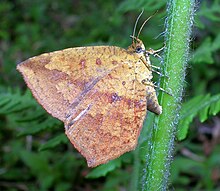
Lepidoptera or lepidopterans is an order of winged insects that includes butterflies and moths. About 180,000 species of the Lepidoptera have been described, representing 10% of the total described species of living organisms, making it the second largest insect order with 126 families and 46 superfamilies, and one of the most widespread and widely recognizable insect orders in the world.
A common classification of the Lepidoptera involves their differentiation into butterflies and moths. Butterflies are a natural monophyletic group, often given the suborder Rhopalocera, which includes Papilionoidea, Hesperiidae (skippers), and Hedylidae. In this taxonomic scheme, moths belong to the suborder Heterocera. Other taxonomic schemes have been proposed, the most common putting the butterflies into the suborder Ditrysia and then the "superfamily" Papilionoidea and ignoring a classification for moths.

Moths are a group of insects that includes all members of the order Lepidoptera that are not butterflies. They were previously classified as suborder Heterocera, but the group is paraphyletic with respect to butterflies and neither subordinate taxon is used in modern classifications. Moths make up the vast majority of the order. There are approximately 160,000 species of moth, many of which have yet to be described. Most species of moth are nocturnal, although there are also crepuscular and diurnal species.

The Sphingidae are a family of moths commonly called sphinx moths, also colloquially known as hawk moths, with many of their caterpillars known as "hornworms"; it includes about 1,450 species. It is best represented in the tropics, but species are found in every region. They are moderate to large in size and are distinguished among moths for their agile and sustained flying ability, similar enough to that of hummingbirds as to be reliably mistaken for them. Their narrow wings and streamlined abdomens are adaptations for rapid flight. The family was named by French zoologist Pierre André Latreille in 1802.

Acanthocereus is a genus of cacti. Its species take the form of shrubs with arching or climbing stems up to several meters in height. The generic name is derived from the Greek word άκανθα (acantha), meaning spine, and the Latin word cereus, meaning candle. The genus is native to the mostly tropical Americas from Texas and the southern tip of Florida to the northern part of South America, including islands of the Caribbean.

Dildo Key is a small island in the Florida Bay in the U.S. state of Florida, located in Everglades National Park. It is named for the Dildo Cactus, a native species. Dildo Key has been noted for its unusual name.
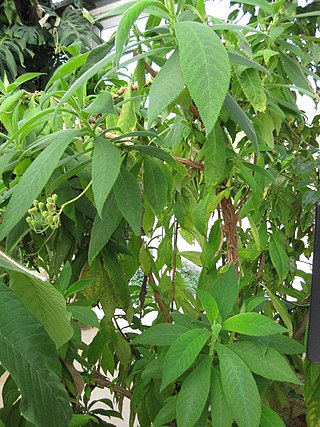
Alloplectus is a genus of Neotropical plants in the family Gesneriaceae. A recent revision of the genus includes five species, with the majority of species in the genus as traditionally circumscribed being transferred to Crantzia, Glossoloma, and Drymonia.
Dildo cactus is a common name used for several species of long, narrow cactus, especially

Acanthocereus tetragonus is a species of cactus that is native to Florida and the Lower Rio Grande Valley of Texas in the United States, Mexico, Central America, the Caribbean, and northern South America. The species is invasive in New Caledonia. Common names include night-blooming cereus, barbed-wire cactus, sword-pear, dildo cactus, triangle cactus, and Órgano-alado de pitaya (Spanish). The miniature cultivar is known as fairy castle cactus. It was originally described by Carl Linnaeus in 1753 as Cactus tetragonus but was moved to the genus Acanthocereus in 1938 by Pieter Wagenaar Hummelinck.
Mirosternus tetragonus is a species of beetle in the family Ptinidae.
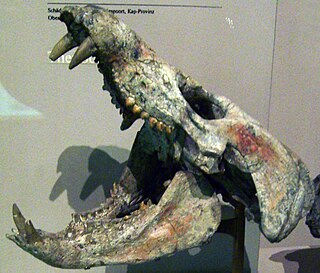
Diademodon is an extinct genus of cynodonts. It was about 2 metres (6.6 ft) long.

Tetragonus catamitus, the common butterfly moth, or Philippine callidulid moth, is a moth of the family Callidulidae. It was first described by Carl Geyer in 1832. Noted from Taiwan, north-eastern India, south-west India, the Andaman and Nicobar Islands, Sri Lanka, the Tenasserim Hills of Myanmar and from Java. They are day-flying moths that can be easily mistaken for a butterfly due to the position in which they hold their wings.
Tetragonus lycaenoides is a moth of the family Callidulidae. It is found in Sulawesi, Borneo, Peninsular Malaysia, Sumatra and Nias.
Pascualgnathus is an extinct genus of traversodontid cynodonts from the Middle Triassic of Argentina. Fossils have been found from the Río Seco de la Quebrada Formation of the Puesto Viejo Group. The type species P. polanskii was named in 1966.

Diademodontidae is an extinct family of Triassic gomphodonts. The best-known genus is Diademodon from South Africa. Titanogomphodon from Namibia may also be a member of Diademodontidae. The Chinese genera Hazhenia and Ordosiodon have also been included in the family, but were more recently identified as baurioid therocephalians. Remains of a diademodontid were reported in the Early-Middle Triassic Fremouw Formation in Antarctica, but that specimen was later referred to the trirachodontid Impidens.
Titanogomphodon is an extinct genus of diademodontid cynodonts from the Middle Triassic Omingonde Formation of Namibia. It is known from a single partial skull that was described in 1973 from the Omingonde Formation. The type and only species is Titanogomphodon crassus. At about 40 centimetres (16 in), the skull of Titanogomphodon was significantly larger than that of its closest relative, Diademodon. Its teeth are similar to those of another group of cynodonts called Traversodontidae, but the similarities are likely the result of convergent evolution. Aside from its larger size, Titanogomphodon differs from Diademodon in having a bony projection on the postorbital bar behind the eye socket.
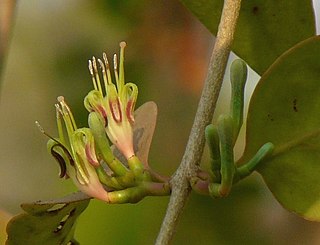
Macrosolen is a genus of plants in the family Loranthaceae. It includes about 83 species all over the world with ca. 40 species widely distributed in tropical South and Southeast Asia. Some species were described by de Loureiro, Lecomte, Danser (1938) and Hô (2003).
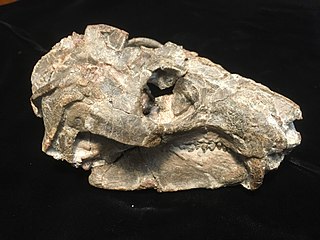
Aleodon is an extinct genus of cynodonts that lived from the Middle to the Late Triassic. Relatively few analyses have been conducted to identify the phylogenetic placement of Aleodon, however those that have place Aleodon as a sister taxon to Chiniquodon. Two species of Aleodon are recognized: A. brachyramphus which was discovered in Tanzania, and A. cromptoni which was discovered most recently in Brazil.
Cyperus tetragonus is a species of sedge that is native to southern parts of North America.

Leucopogon tetragonus is a species of flowering plant in the family Ericaceae, and is endemic to the south of Western Australia. It is a robust shrub with crowded, often decussate, oblong to lance-shaped leaves and short, dense spikes of white, tube-shaped flowers.
